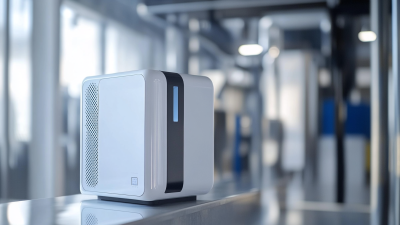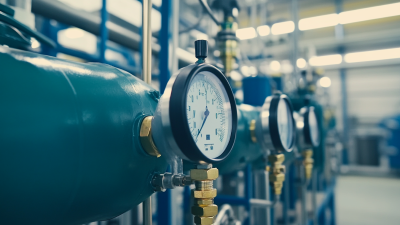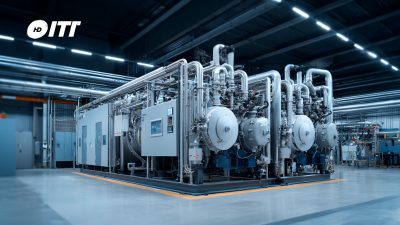
- sales@bjbod.com
- Mon - Sat at 7:00AM to 9:00PM

In the realm of industrial processes, understanding the "Compressed Air Dew Point" is crucial for ensuring optimal system performance and reliability. According to the Compressed Air and Gas Institute, moisture in compressed air systems can lead to significant operational issues, such as equipment corrosion, reduced efficiency, and product contamination. Data indicates that approximately 70% of industrial air systems experience moisture problems, emphasizing the importance of monitoring and controlling the dew point. By maintaining the compressed air dew point within the appropriate range, companies can not only safeguard their equipment but also enhance energy efficiency and reduce maintenance costs. Consequently, this article aims to delve into the key metrics associated with compressed air dew point, offering practical insights into how businesses can optimize their systems for superior performance and reliability.

The dew point in compressed air systems is a critical indicator of the moisture content in the air. It represents the temperature at which air becomes saturated and water vapor begins to condense into liquid water. Understanding this metric is essential for preventing issues such as corrosion, oil contamination, and microbial growth. High moisture levels in compressed air can compromise product quality and reduce the lifespan of equipment, making dew point monitoring a vital practice in maintaining system health.
Proper management of dew point enables operators to optimize drying processes and select appropriate filtration solutions. By ensuring that the dew point is maintained at recommended levels, businesses can enhance the efficiency of their operations and protect their investments in pneumatic machinery. This foresight not only improves performance but also aligns with best practices in energy consumption, as drier air systems typically operate with greater effectiveness and lower energy costs. Thus, prioritizing dew point monitoring is key to achieving sustainable and reliable performance in compressed air applications.
When measuring the dew point in compressed air systems, several key metrics come into play that are essential for optimal system performance. The dew point itself is the temperature at which moisture in the air condenses into water, and understanding this parameter is crucial for preventing corrosion, product spoilage, and other moisture-related issues. One of the primary metrics to consider is the dew point temperature, which directly indicates how much moisture the air can hold. A lower dew point temperature signifies drier air, which is often desired in industrial applications to ensure equipment longevity and operational efficiency.
Another vital metric is the pressure dew point, which accounts for the effect of pressure on the moisture content of the compressed air. As pressure increases, the dew point also changes, meaning that systems may require different moisture control strategies based on operational pressures. Additionally, the use of dew point monitors provides real-time data, allowing operators to adjust the system dynamically to maintain optimal conditions. Together, these metrics help in assessing and managing air quality, ultimately contributing to the reliability and safety of compressed air systems.
Understanding the dew point levels in compressed air systems is crucial for optimal performance. Several factors influence these levels, including temperature, humidity, and the presence of water vapor. For instance, high temperatures and humidity typically lead to increased dew point readings, which can adversely affect equipment efficiency and lead to moisture-related issues within the system. According to industry reports, maintaining a dew point of -40°F to -70°F is optimal for compressed air applications to ensure minimal risk of condensation and contamination.

In addition to environmental conditions, the design and function of air dryers play a significant role in controlling dew point levels. Hybrid air dryers, which combine refrigeration and desiccant technologies, have been shown to be particularly effective in achieving low dew points while also saving energy. Tips for maintaining an optimal dew point include regularly inspecting and servicing air filters, implementing appropriate air dryer systems, and monitoring ambient conditions to ensure that any changes that may affect humidity levels are promptly addressed.
It's essential for facilities using compressed air systems to be proactive in understanding these influencing factors to reduce downtime and improve overall system reliability. Utilizing available metrics and tools can assist operators in making informed decisions that enhance performance and prolong equipment lifespan.
Maintaining an optimal dew point in compressed air systems is crucial for ensuring performance and longevity. A dew point that is too high can lead to moisture issues, while an excessively low dew point may cause dryness that is detrimental to pneumatic tools and processes. According to ASHRAE guidelines, the recommended dew point for compressed air systems in industrial settings typically ranges from 35°F to 45°F (1.6°C to 7.2°C) to prevent condensation and safeguard system integrity.
Best practices for maintaining this dew point include regular monitoring using hygrometers, installing proper filtration systems, and utilizing desiccant dryers where necessary. Additionally, recent advancements in thermal-driven dehumidification technologies have opened doors for more efficient humidity control, minimizing energy consumption while enhancing performance. Reports indicate that implementing these technologies can reduce operational costs by as much as 20%, thus reinforcing the importance of adopting innovative solutions for effective humidity management in compressed air systems.

Troubleshooting dew point issues is essential for maintaining optimal performance in compressed air systems. A high dew point can lead to excessive moisture entering the system, which may cause corrosion, microbial growth, and equipment failure. Regularly monitoring the dew point is crucial; using dew point sensors can help identify potential problems before they escalate. Ensuring that the air dryer selected is suitable for the specific application and operating conditions is also vital.
When dew point problems arise, operators should first check the maintenance status of the air dryer and filtration system. Clogged filters or improperly functioning dryers can significantly increase the dew point. Additionally, it's important to assess the entire compressed air network for leaks, as they can introduce atmospheric moisture into the system. Addressing these issues promptly can enhance system reliability, extend equipment life, and improve overall efficiency. Proper training for personnel on identifying and resolving dew point-related issues can lead to proactive maintenance practices, ultimately safeguarding against costly downtime and repairs.
This chart illustrates the relationship between the compressed air dew point temperature and the corresponding humidity levels, showing how variations can impact system performance.





